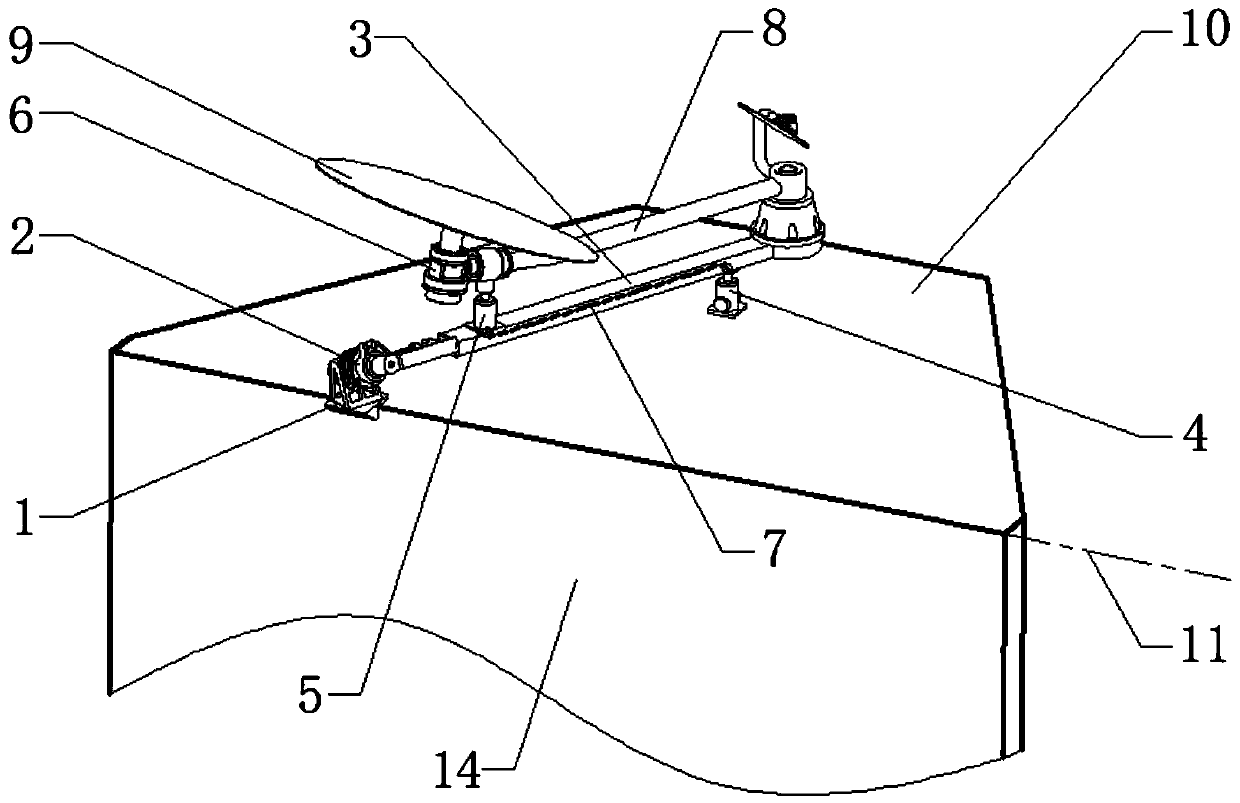Satellite-borne antenna deployable mechanism
A technology for deploying mechanism and spaceborne antenna, which is applied to antennas, foldable antennas, antenna components, etc., can solve the problems of increased mechanism weight, low antenna stiffness, low natural frequency, etc., so as to reduce the impact of the deployment action and reduce the structure. The effect of weight, complexity reduction
- Summary
- Abstract
- Description
- Claims
- Application Information
AI Technical Summary
Problems solved by technology
Method used
Image
Examples
Embodiment 1
[0028] refer to figure 1 figure 2 . In the preferred embodiment described below, a spaceborne antenna deployable mechanism includes a passively driven synchronous gear transmission joint hinge 2 installed on the satellite body 14 and one end is hinged and fixed to the satellite body through the synchronous gear transmission joint hinge 2 The extension arm 3 on 14, the antenna 8 connected by the antenna rotation shaft 16 at the other end, and the passive drive hinge 6 installed on the antenna reflector 9 at the free end of the antenna 8 connecting rod, is characterized in that: it is installed on the extension arm 3 There is an unlocking mechanism 5 corresponding to the passively driven hinge 6 and a locking mechanism 4 located below the extension arm 3 corresponding to the passively driven hinge 2. When in the state of transmitting and retracting, the antenna reflector 9 is connected to the joint through the passively driven hinge 6 After rotation, it is fixed on the extens...
Embodiment 2
[0034] combine image 3 . The expandable mechanism of the spaceborne antenna in this embodiment is to maximize the space utilization. When the antenna is stored, the antenna needs to be arranged on the fixed surface 10 of the satellite body 14 in the antenna storage state, and the antenna 8 on the end of the extension arm 3 is turned over to a specific angle during work. When the extension arm 3 rotates along the fixed surface 10 in the antenna storage state to the fixed surface 12 in the antenna unfolded state by any angle α, the angle between the vertical line between the extension arm 3 and the initial connection axis of the extension arm is β, and the space angle β is 0°< When β≤90° is arranged, the rotation axis of the antenna 8 is always perpendicular to the fixed surface 12 in the unfolded state of the antenna. At the same time, the direction of the rotation axis 13 of the hinge 2 is determined by the plane method formed by the axis of the extension arm 3 in the two st...
Embodiment 3
[0036] refer to Figure 4 . In the expandable mechanism of the spaceborne antenna in this embodiment, the locking mechanism 4 and the unlocking mechanism 5 have a linkage unlocking structure. The locking mechanism 4 and the unlocking mechanism 5 realize flexible linkage through the cable 7 . A hinge device is respectively arranged at both ends of the drag cable 7, and a torsion spring (or only a hinge near the unlocking mechanism 5) is arranged on the rotation nodes of the two hinges. The direction of the driving force of the torsion spring is shown by the rotation arrow in the figure. After the locking mechanism 4 is unlocked, the right slider moves upwards, and the cable 7 is driven by the elastic potential energy of the torsion spring to move along the unlocking movement direction 15, and the left slider is pulled to move downward, thereby completing the unlocking of the unlocking mechanism 5 and realizing locking The linkage unlocking of mechanism 4 and unlocking mechani...
PUM
 Login to View More
Login to View More Abstract
Description
Claims
Application Information
 Login to View More
Login to View More - R&D
- Intellectual Property
- Life Sciences
- Materials
- Tech Scout
- Unparalleled Data Quality
- Higher Quality Content
- 60% Fewer Hallucinations
Browse by: Latest US Patents, China's latest patents, Technical Efficacy Thesaurus, Application Domain, Technology Topic, Popular Technical Reports.
© 2025 PatSnap. All rights reserved.Legal|Privacy policy|Modern Slavery Act Transparency Statement|Sitemap|About US| Contact US: help@patsnap.com



